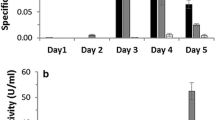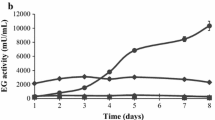Abstract
The aflatoxin-producer and opportunistic plant pathogenic, filamentous fungus Aspergillus flavus is responsible for the contamination of corn and other important agricultural commodities. In order to obtain nutrients from the host A. flavus produces a variety of extracellular hydrolytic enzymes. Interestingly, A. flavus amylase and protease activity are dependent on the global regulator veA, a gene known to regulate morphogenesis and secondary metabolism in numerous fungi. Analysis of starch degradation by fungal enzymes secreted into broths of starch- or corn kernel-based media showed a notable accumulation of glucose in samples of the A. flavus control strain while the deletion veA sample accumulated high levels of maltose and maltotriose and only a small amount of glucose. Furthermore, SDS-PAGE and proteomics analysis of culture broths from starch- or corn kernel-based media demonstrated differential production of a number of proteins that included a reduction in the amount of a glucoamylase protein in the veA mutant compared to the control strain, while an alpha-amylase was produced in greater quantities in the veA mutant. Quantitative real-time PCR and western blot analyses using anti-glucoamylase or alpha-amylase antisera supported the proteomics results. Additionally, an overall reduction in protease activity was observed in the veA mutant including production of the alkaline protease, oryzin, compared to the control strain. These findings contribute to our knowledge of mechanisms controlling production of hydrolases and other extracellular proteins during growth of A. flavus on natural starch-based substrates.









Similar content being viewed by others
References
Amaike S, Keller NP (2009) Distinct roles for VeA and LaeA in development and pathogenesis of Aspergillus flavus. Eukaryot Cell 8(7):1051–1060. doi:10.1128/EC.00088-09
Araujo-Bazan L, Dhingra S, Chu J, Fernandez-Martinez J, Calvo AM, Espeso EA (2009) Importin alpha is an essential nuclear import carrier adaptor required for proper sexual and asexual development and secondary metabolism in Aspergillus nidulans. Fungal Genet Biol 46(6–7):506–515. doi:10.1016/j.fgb.2009.03.006
Bayram O, Krappmann S, Ni M, Bok JW, Helmstaedt K, Valerius O, Braus-Stromeyer S, Kwon NJ, Keller NP, Yu JH, Braus GH (2008) VelB/VeA/LaeA complex coordinates light signal with fungal development and secondary metabolism. Science 320(5882):1504–1506. doi:10.1126/science.1155888
Bok J-W, Keller NP (2004) LaeA, a regulator of secondary metabolism in Aspergillus spp. Eukaryot Cell 3(2):527–535. doi:10.1128/EC.3.2.527-535.2004
Calvo AM (2008) The VeA regulatory system and its role in morphological and chemical development in fungi. Fungal Genet Biol 45(7):1053–1061. doi:10.1016/j.fgb.2008.03.014
Cary JW, O’Brian GR, Nielsen DM, Nierman W, Harris-Coward P, Yu J, Bhatnagar D, Cleveland TE, Payne GA, Calvo AM (2007) Elucidation of veA-dependent genes associated with aflatoxin and sclerotial production in Aspergillus flavus by functional genomics. Appl Microbiol Biotechnol 76(5):1107–1118. doi:10.1007/s00253-007-1081-y
Cary JW, Harris-Coward PY, Ehrlich KC, Mack BM, Kale SP, Larey C, Calvo AM (2012) NsdC and NsdD affect Aspergillus flavus morphogenesis and aflatoxin production. Eukaryot Cell 11(9):1104–1111. doi:10.1128/EC.00069-12
Chen Z-Y, Brown RL, Cary JW, Damann KE, Cleveland TE (2009) Characterization of an Aspergillus flavus alkaline protease and its role in the infection of maize kernels. Toxin Rev 28:187–197. doi:10.1080/15569540903089221
Dhingra S, Andes D, Calvo AM (2012) VeA regulates conidiation, gliotoxin production, and protease activity in the opportunistic human pathogen Aspergillus fumigatus. Eukaryot Cell 11(12):1531–1543. doi:10.1128/EC.00222-12
Dolezal AL, Obrian GR, Nielsen DM, Woloshuk CP, Boston RS, Payne GA (2013) Localization, morphology and transcriptional profile of Aspergillus flavus during seed colonization. Mol Plant Pathol. doi:10.1111/mpp.12056
Duran RM, Cary JW, Calvo AM (2007) Production of cyclopiazonic acid, aflatrem, and aflatoxin by Aspergillus flavus is regulated by veA, a gene necessary for sclerotial formation. Appl Microbiol Biotechnol 73(5):1158–1168. doi:10.1007/s00253-006-0581-5
Duran RM, Cary JW, Calvo AM (2009) The role of veA in Aspergillus flavus infection of peanut, corn and cotton. The Open Mycology J 3:27–36 doi: 1874-4370/09
Dvorackova I, Kusak V (1990) Hepatocellular carcinoma (a 28-year necropsy review). J Environ Pathol Toxicol Oncol 10(4–5):220–224
Fakhoury AM, Woloshuk CP (1999) Amy1, the alpha-amylase gene of Aspergillus flavus: involvement in aflatoxin biosynthesis in maize kernels. Phytopathology 89(10):908–914. doi:10.1094/PHYTO.1999.89.10.908
Frebort I, Tanaka S, Matsushita K, Adachi O (2000) Cellular localization and metabolic function of n-butylamine-induced amine oxidases in the fungus Aspergillus niger AKU 3302. Arch Microbiol 173(5–6):358–365. doi:10.1007/s002030000154
Harayama F (1992) Function of glutaminase in the process of rice miso fermentation. J Brew Soc Jpn 87:503–509
Kafer E (1977) Meiotic and mitotic recombination in Aspergillus and its chromosomal aberrations. Adv Genet 19:33–131
Kale SP, Milde L, Trapp MK, Frisvad JC, Keller NP, Bok JW (2008) Requirement of LaeA for secondary metabolism and sclerotial production in Aspergillus flavus. Fungal Genet Biol 45(10):1422–1429. doi:10.1016/j.fgb.2008.06.009
Kawasaki L, Wysong D, Diamond R, Aguirre J (1997) Two divergent catalase genes are differentially regulated during Aspergillus nidulans development and oxidative stress. J Bacteriol 179(10):3284–3292
Koc O, Metin K (2010) Purification and characterization of a thermostable glucoamylase produced by Aspergillus flavus HBF34. Afr J Biotechnol 9:3414–3424. doi:10.4314%2Fajb.v9i23
Livak KJ, Schmittgen TD (2001) Analysis of relative gene expression data using real-time quantitative PCR and the 2(−Delta Delta C(T)) method. Methods 25(4):402–408. doi:10.1006/meth.2001.1262
Medina ML, Haynes PA, Breci L, Francisco WA (2005) Analysis of secreted proteins from Aspergillus flavus. Proteomics 5(12):3153–3161. doi:10.1002/pmic.200401136
Mellon JE, Cotty PJ (1995) Expression of elastinolytic activity among isolates in Aspergillus section Flavi. Mycopathologia 131(2):115–120
Mellon JE, Cotty PJ, Dowd MK (2007) Aspergillus flavus hydrolases: their roles in pathogenesis and substrate utilization. Appl Microbiol Biotechnol 77(3):497–504. doi:10.1007/s00253-007-1201-8
Myung K, Zitomer NC, Duvall M, Glenn AE, Riley RT, Calvo AM (2012) The conserved global regulator VeA is necessary for symptom production and mycotoxin synthesis in maize seedlings by Fusarium verticillioides. Plant Pathol 61(1):152–160. doi:10.1111/j.1365-3059.2011.02504.x
Oda K, Kakizono D, Yamada O, Iefuji H, Akita O, Iwashita K (2006) Proteomic analysis of extracellular proteins from Aspergillus oryzae grown under submerged and solid-state culture conditions. Appl Environ Microbiol 72(5):3448–3457. doi:10.1128/AEM.72.5.3448-3457.2006
Paper JM, Scott-Craig JS, Adhikari ND, Cuomo CA, Walton JD (2007) Comparative proteomics of extracellular proteins in vitro and in planta from the pathogenic fungus Fusarium graminearum. Proteomics 7(17):3171–3183. doi:10.1002/pmic.200700184
Payne GP, Brown MP (1998) Genetics and physiology of aflatoxin biosynthesis. Annu Rev Phytopathol 36:329–362
Probst C, Schulthess F, Cotty PJ (2010) Impact of Aspergillus section Flavi community structure on the development of lethal levels of aflatoxins in Kenyan maize (Zea mays). J Appl Microbiol 108(2):600–610. doi:10.1111/j.1365-2672.2009.04458.x
Reichard U, Monod M, Odds F, Ruchel R (1997) Virulence of an aspergillopepsin-deficient mutant of Aspergillus fumigatus and evidence for another aspartic proteinase linked to the fungal cell wall. J Med Vet Mycol : Bi-Monthly Publ Int Soc Human Anim Mycol 35(3):189–196
Ross RK, Yu MC, Henderson BE, Yuan JM, Qian GS, Tu JT, Gao YT, Wogan GN, Groopman JD (1992) Urinary aflatoxin biomarkers and risk of hepatocellular carcinoma. Lancet 339(8799):943–946. doi:10.1016/0140-6736(92)91528-G
Skamnioti P, Henderson C, Zhang Z, Robinson Z, Gurr SJ (2007) A novel role for catalase B in the maintenance of fungal cell-wall integrity during host invasion in the rice blast fungus Magnaporthe grisea. Mol Plant Microbe Interact 20(5):568–580. doi:10.1094/MPMI-20-5-0568
Stinnett SM, Espeso EA, Cobeno L, Araujo-Bazan L, Calvo AM (2007) Aspergillus nidulans VeA subcellular localization is dependent on the importin alpha carrier and on light. Mol Microbiol 63(1):242–255. doi:10.1111/j.1365-2958.2006.05506.x
Sweeney MJ, Dobson AD (1999) Molecular biology of mycotoxin biosynthesis. FEMS Microbiol Lett 175(2):149–163
Tokuoka M, Seshime Y, Fujii I, Kitamoto K, Takahashi T, Koyama Y (2008) Identification of a novel polyketide synthase–nonribosomal peptide synthetase (PKS–NRPS) gene required for the biosynthesis of cyclopiazonic acid in Aspergillus oryzae. Fungal Genet Biol 45(12):1608–1615. doi:10.1016/j.fgb.2008.09.006
Trail F, Mahanti N, Linz J (1995) Molecular biology of aflatoxin biosynthesis. Microbiology 141(Pt 4):755–765
Turner PC, Moore SE, Hall AJ, Prentice AM, Wild CP (2003) Modification of immune function through exposure to dietary aflatoxin in Gambian children. Environ Health Perspect 111(2):217–220
Woloshuk CP, Cavaletto JR, Cleveland TE (1997) Inducers of aflatoxin biosynthesis from colonized maize kernels are generated by an amylase activity from Aspergillus flavus. Phytopathology 87(2):164–169
Wu F (2004) Mycotoxin risk assessment for the purpose of setting international regulatory standards. Environ Sci Technol 38(15):4049–4055
Zhang S, Monahan BJ, Tkacz JS, Scott B (2004) Indole-diterpene gene cluster from Aspergillus flavus. Appl Environ Microbiol 70(11):6875–6883. doi:10.1128/AEM.70.11.6875-6883.2004
Zhu W, Wei W, Fu Y, Cheng J, Xie J, Li G, Yi X, Kang Z, Dickman MB, Jiang D (2013) A secretory protein of necrotrophic fungus Sclerotinia sclerotiorum that suppresses host resistance. PLoS One 8(1):e53901. doi:10.1371/journal.pone.0053901
Acknowledgements
This project was funded by USDA-SCA 58-6435-9-386 and the Department of Biological Sciences at NIU. We wish to thank Jessica Lohmar and Barbara Ball for technical support.
Author information
Authors and Affiliations
Corresponding author
Additional information
Rocio M. Duran and Scott Gregersen contributed equally to this work.
Electronic supplementary material
Below is the link to the electronic supplementary material.
ESM 1
(PDF 61 kb)
Rights and permissions
About this article
Cite this article
Duran, R.M., Gregersen, S., Smith, T.D. et al. The role of Aspergillus flavus veA in the production of extracellular proteins during growth on starch substrates. Appl Microbiol Biotechnol 98, 5081–5094 (2014). https://doi.org/10.1007/s00253-014-5598-6
Received:
Revised:
Accepted:
Published:
Issue Date:
DOI: https://doi.org/10.1007/s00253-014-5598-6




